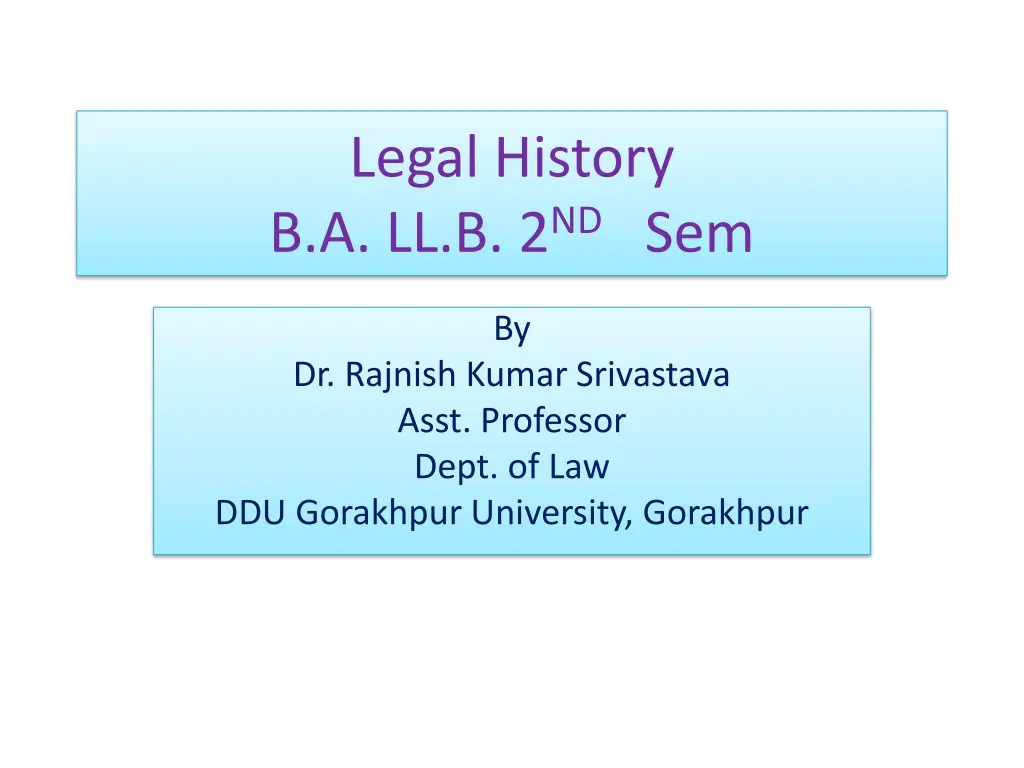
Evolution of Judicial System in British India
Explore the historical development of the judicial system in British India, focusing on the establishment of Mayor's Courts and their role in unifying the justice system in presidency cities. Learn about the transition to British law and the appellate process up to the Privy Council.
Download Presentation

Please find below an Image/Link to download the presentation.
The content on the website is provided AS IS for your information and personal use only. It may not be sold, licensed, or shared on other websites without obtaining consent from the author. If you encounter any issues during the download, it is possible that the publisher has removed the file from their server.
You are allowed to download the files provided on this website for personal or commercial use, subject to the condition that they are used lawfully. All files are the property of their respective owners.
The content on the website is provided AS IS for your information and personal use only. It may not be sold, licensed, or shared on other websites without obtaining consent from the author.
E N D
Presentation Transcript
Legal History B.A. LL.B. 2NDSem By Dr. Rajnish Kumar Srivastava Asst. Professor Dept. of Law DDU Gorakhpur University, Gorakhpur
The Early Development of the Judicial System through Courts in British Period Mayor's Court For the Company, the gazette issued by George 1st, the King of England, on 24th September 1726 and provided a new orientation to the development of judicial institutions in the three presidency cities. In the past there was a different- different system of justice in the three cities.
As a result of which the justice system could not be developed satisfactorily. The gazette sought to unify the justice system in the three cities. In every presidency town this gazette established a common judicial institution and thereafter development in the judicial system remained almost the same. This gazette established a civil and criminal court in the presidency cities whose authority was granted by the King. Thus, these courts can be treated as equal to the Imperial Courts.
In every presidency city the Mayor and Aldermen together constituted the Mayor s court. The quorum of the court was fixed consisting of the Mayor or the Senior Alderman and two other Alderman. This court had the right to hear and trial of all the civil suits which might have originated in the city. The first appeal from this court could have been produced to the Governor and Council within 14 days. Within 14 days a further appeal was likely to be made to the Privy Council in suits worth 1000 pagoda or above.
Thus, the right to appeal to the Privy Council to the courts of India was for the first time granted. The Mayor's Court was the Court of Record" and thus had the power to punish persons who might be found guilty of contempt. This court was also having a testamentary jurisdiction and could thus grant certificates of wills of deceased persons.
the Mayor Court had to take its decision on the basis of 'Justice and Right', and it was laid down in the In the gazette of 1661, that the courts would follow British law, so it was clear that the Mayor Court also had to function as the British Court.
Adalat System of the Company In the administration plan of 1772 the Bengal, Bihar and Orissa were divided into a number of districts. An English employee of the company was appointed as a collector in every district. He was given the task of collection of land revenue. The judicial plan was also connected with the scheme and the following courts were set up
The Mofussil Diwani Adalat The Mofussil Diwani Adalat was established in each district in which the collector was appointed as Judge. This court was assigned the jurisdiction of all civil cases. In religious matters this court used Hindu law for the Hindus and Muslim law for the Muslims.
The Small Cause Adalat The Small Cause Adalat was arranged with the objective of settling the small cases easily. The cases were disposed of by this court by the 'Pradhan' of the village. This court had the power to decide the cases up to Rs.10.
The Mofussil Faoujdari Adalat the set up of a Mofussil Faoujdari Adalat was in every district to adjudicate criminal cases. In this court their was the Muslim law officers like the qazi, the mufti and the maulvis for interpret the Muslim law on crime. The collector had to take a general control over the court. He was entrusted with the responsibility to bear in mind the fact that the court had heard all the witnesses, tried the cases regularly and had made an impartial judgment. This court could not have decided the cases where the sentence of death was passed. The Sadar Adalat had the right to the final disposal of such cases.
Sadar Adalat Above the Mofussil Adalat, two senior courts, the Sadar Diwani Adalat and the Sadar Nizamat Adalat were established in Kolkata. The Sadar Diwani Adalat consisted of the governor and the members of council and the function of the court was to hear appeals from cases of more than Rs. 500 from the Mofussil Diwani Adalat.
In the Sadar Nizamat Adalat there was a Muslim judge designated as the "Daroga -A- Adalat" and there was a qazi to render advice and assistance to him. All these persons were appointed by the "Nawab" on the advice of the Governor. The function of the court was to review the decision of the Mofussil Faoujdari Adalat and to finally approve the sentence of death sentence. The death warrant for death was prepared by the court and signed by the "Nawab" as the head of the Nizamat.
